TABLE OF CONTENTS
- Introduction
- DLC
- Overview
- Dynasty Banners
- House Banners
- Fixed Historic Artifacts
- Random Religious Artifacts
- Random Non-Unique Artifacts
- Analysis
This article was written under Crusader Kings 3 Game Version: Peacock (1.11.4)
Please note that much of the information in this article is based on anecdotal evidence and a lot of trial and error. I have not had the opportunity to delve into the actual source code, but I am happy to make any corrections if more accurate information is discovered. If you have any comments, you can either post here or e-mail me at: [email protected]
1. INTRODUCTION
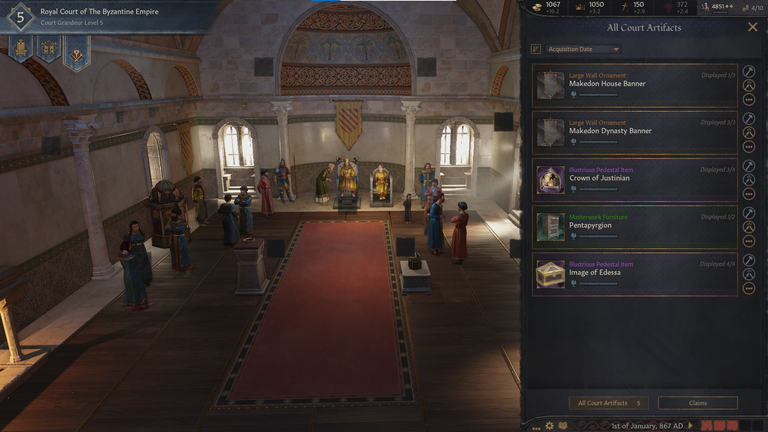
This article explains how the starting artifacts in the 867 start are allocated. Knowing how the system works can give you a major head start on your artifact collecting.
Crusader Kings 3 includes various mundane and legendary artifacts that can be worn by your character in their inventory (crown, weapon, armor, regalia, and 4 trinkets) and court artifacts that can be displayed in the royal court of a character of King or Emperor rank (throne, 3 large wall ornaments, 3 small wall ornaments, 2 furniture, 2 books, and 4 pedestal items). This adds an RPG dimension to CK3 as you try to equip your character (and dynasty) with the best inventory equipment and court artifacts.
Back in CK2, artifacts were initially represented as modifiers (like the Iron Crown of Lombardy or the +2 Axe) but the system was fleshed out later with the Monks and Mystics DLC. The CK3 mechanic also reminds me of the Great Works system that started in Civilization IV and the artifact collecting that started in Civilization V.
While the Crusader Kings 3 Wiki has a detailed section on artifacts https://ck3.paradoxwikis.com/Artifacts, the information can be confusing because it does not separate out the information for the 867 start date from the 1066 start date. Furthermore, it doesn't really explain the generation of random artifacts.
So this article is going to provide detailed information about the starting artifacts in 867. There will be a follow-up article about the starting artifacts in 1066. And then I will write up a summary that compares the two start dates. (While in CK2 you could choose any start date, in CK3 you currently can only choose between 867 and 1066, which does make writing articles and guides a bit easier since you only have to cover two scenarios.)
The other two articles can be found here:
https://peakd.com/ck3/@byzantinekitty/ck3-starting-artifacts-in-1066
https://peakd.com/ck3/@byzantinekitty/ck3-867-vs-1066-starting-artifacts
2. DLC
For CK3, the Royal Court DLC added the royal court feature where you can display court artifacts and also introduced inspired people who you can sponsor to create artifacts for you.
The Fate of Iberia DLC added a few new artifacts (Bells of Santiago, Visigothic Votive Crown, Chalice of Dona Urraca).
The Tours and Tournaments DLC significantly reworked how artifacts could be obtained. Hunts now regularly generate mundane artifacts, prizes can be won in grand tournaments, and books can be obtained from university visits.
The Legacy of Persia DLC added some new artifacts (Sassanian Sword, Achaemenid Drinking Vessel, Oxus Bracelet, Incense Burner Sculpture), many of which can be obtained during random travel events in the Persia region:
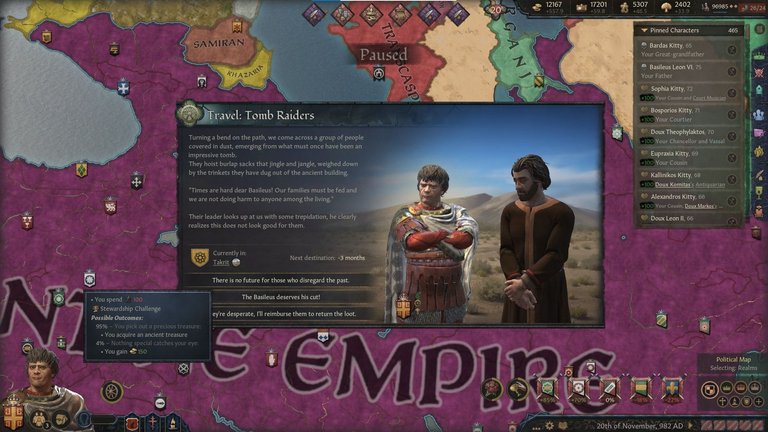
- One event is when you run across tomb raiders and have three different options to choose from. You can gain piety and a modifier that increases control growth and Courtly and Zealot vassal opinion but at the cost of decreased popular opinion. Another option is to lose gold to gain piety and a modifier to increase popular opinion. Or you can spend piety to attempt a Stewardship challenge which can give you a random artifact or an Ancient Treasures character modifier (which increases your prestige and gives a bonus to Courtly vassal opinion).
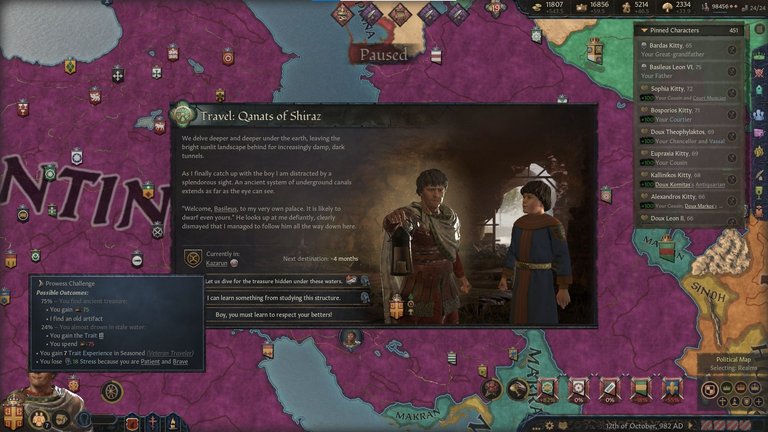
- A second event is when you encounter a child who vanishes into some caves. If you pass a Prowess challenge you can follow the child. You then have the option of gaining prestige, studying the qanats by passing a Learning challenge to gain prestige and a bonus to development growth, or passing a Prowess challenge to gain prestige and a random artifact.
In both of these events (which only seem to trigger once each for a given character), you can get artifacts such as a Sassanian Sword (I've seen Masterwork, Famed, and Illustrious versions. Common might be possible too), Achaemenid Drinking Vessels as an inventory trinket (which come in Common, Masterwork, Famed, and Illustrious versions and can be turned into pedestal court artifacts), Illustrious Oxus Bracelets (with varying effects), or Muslim or Zoroastrian religious artifacts (such as a Sword of Muhammad or Branch of the Sacred Cypress of Kashmar).
- Thirdly, there is an event where you encounter Zoroastrians trying to save the dying embers of their sacred fire. If you offer them shelter, you have the chance to steal the embers, which gives you an Afarganyu artifact (there is a pedestal version and a trinket version) - however only Zoroastrian characters get the full benefit of the artifact.
3. OVERVIEW
I have grouped the artifacts into categories that I think make sense:
- Dynasty Banners
- House Banners
- Fixed Historic Artifacts
- Random Religious Artifacts
- Random Non-Unique Artifacts
At the start of the game, every ruler with a royal court gets a House Banner and, if they are Dynasty Head, a Dynasty Banner as well.
There are 4 inventory artifacts and 13 royal court artifacts that are always allocated to specific historic characters in 867.
6 Christian, 6 Muslim, 4 Buddhist, and 2 Hindu religious artifacts are randomly generated and given to King or Emperor characters of the appropriate religion (theocracies are not eligible).
2 Asatru, 1 Slavic, and 1 Senegambian religious artifacts are randomly generated and given to Count or Duke characters of the appropriate religion (mercenary leaders are eligible).
5 Visigothic Votive Crowns are given to random Iberian rulers that are of Count rank or higher. And 6 Excaliburs are given to random Counts or Dukes in Britannia or Francia.
4. DYNASTY BANNERS
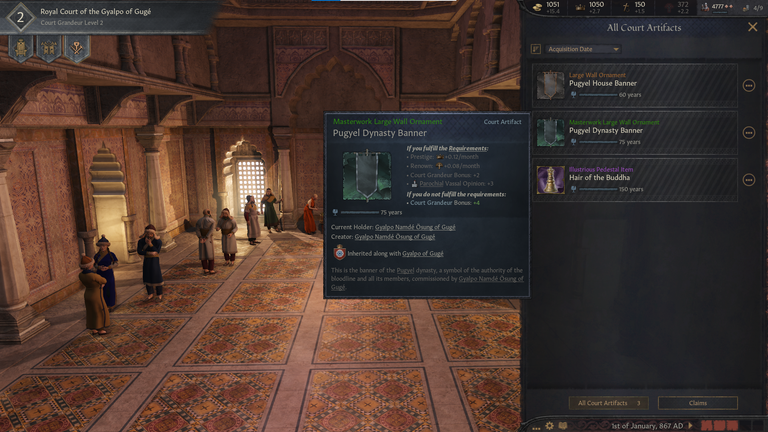
Every ruler with a royal court (i.e. King or Emperor level and who is not a Theocracy) who is their Dynasty Head starts with a Dynasty Banner. The quality of the Dynasty Banner seems to be related to the Level of Splendor of that dynasty. In 867, all Dynasty Banners will be Common or Masterwork (in 1066 there is a single Dynasty Banner that starts at Famed level).
As your dynasty accumulates Renown and improves its Level of Splendor, the Dynasty Banner (but not any House Banners) will periodically upgrade in quality level. However, when this happens, the effects at the new level are completely rerolled - the Dynasty Banner may not necessarily retain any of the effects it previously had.
5. HOUSE BANNERS
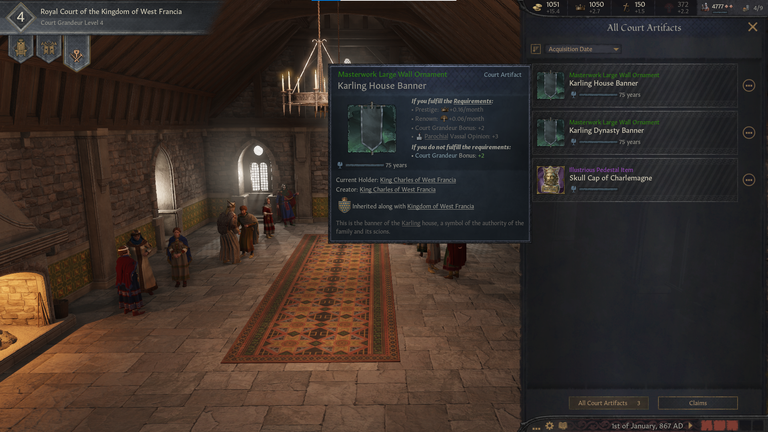
Every ruler with a royal court starts with a House Banner, regardless of whether or not they are their House Head. This can result in the existence of multiple House Banners for the same house, if there are multiple kings or emperors from the same house. For example, in 867 there will be multiple Karling House Banners and in 1066 there will be multiple Jimena House Banners.
The quality of the House Banner seems to be related to the Level of Splendor of that dynasty. In 867, all House Banners will be Common or Masterwork.
6. FIXED HISTORIC ARTIFACTS
In 867 there are 4 fixed inventory artifacts that are always allocated to specific historic characters:
| Character | Location | Artifact | Quality | Type | Requirements |
|---|---|---|---|---|---|
| Pope Nicolaus | Papacy | Papal Tiara | Illustrious | Crown | Papacy Only |
| Count Hermenexildo Gutierrez of Santiago | County of Santiago | Bells of Santiago | Illustrious | Trinket | Christian (Convertible for Muslims) AND Involved or Interloper in Iberian Struggle |
| Caliph al-Mu'tazz ibn al-Mutawakkil of the Abbasid Empire | Arabian Empire | Mantle of the Prophet | Illustrious | Regalia | Muslim |
| Sheikh Rostam Qarinzade of Mazandaran | County of Mazandaran | Sassanian Sword | Illustrious | Regalia |
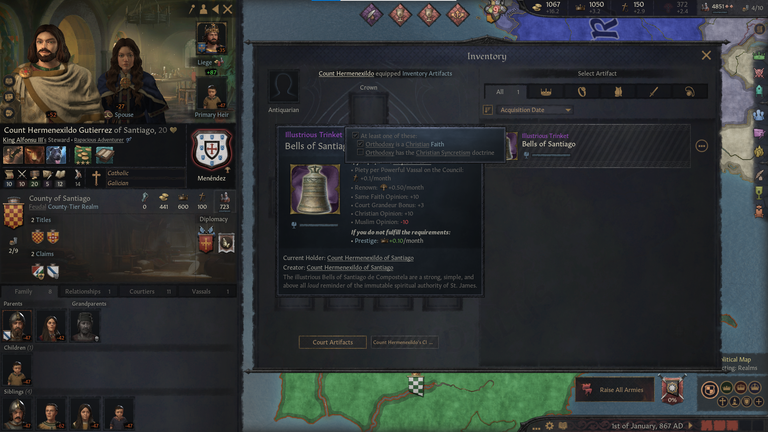
The Bells of Santiago requires the Fate of Iberia DLC. It can only be used by Christian characters but Muslim owners have access to a decision to reforge them as the Former Bells of Santiago, which is only usable by Muslim characters. In turn, a Christian owner of the Former Bells of Santiago can reforge them back into the Bells of Santiago.
Please note that besides the religion requirement, only a character who is Involved or an Interloper in the Iberian Struggle can utilize the full benefits of the Bells (or Former Bells). This requirement is not clear from the tooltip. So if you are a Christian/Muslim ruler outside of Iberia and the tooltip shows that you do not meet the requirements (even though you are of the correct religion), it is because you do not fulfill the Involved/Interloper requirement.
The Sassanian Sword requires the Legacy of Persia DLC and is regalia (not a weapon). It is not unique. Other Sassanian Swords (of varying quality levels) can be found during random travel events in the Persia region. Also the stats are not fixed. Sheikh Rostam Qarinzade of Mazandaran will always start with an Illustrious Sassanian Sword but the exact effects may vary from game to game.
In 867 there are 13 fixed royal court artifacts that are always allocated to specific historic characters:
| Character | Location | Artifact | Quality | Type | Requirements |
|---|---|---|---|---|---|
| Basileus Basileious of the Byzantine Empire | Byzantine Empire | Crown of Justinian | Illustrious | Pedestal | |
| Basileus Basileious of the Byzantine Empire | Byzantine Empire | Image of Edessa | Illustrious | Pedestal | Christian |
| Basileus Basileious of the Byzantine Empire | Byzantine Empire | Pentapyrgion | Masterwork | Furniture | |
| King Charles II "the Bald" of West Francia | Kingdom of West Francia | Skull Cap of Charlemagne | Illustrious | Pedestal | |
| King Causantin II MacCinead of Alba | Kingdom of Alba | Stone of Scone | Illustrious | Throne | |
| Caliph al-Mu'tazz ibn al-Mutawakkil of the Abbasid Empire | Arabian Empire | Spear of the Prophet | Illustrious | Pedestal | Muslim |
| Amir-e Amiran Ya'qub Laythzade of the Saffarid Grand Amirate | Kingdom of Makran | Derafsh Kaviani | Illustrious | Large Wall Ornament | Iranian culture |
| Amir-e Amiran Ya'qub Laythzade of the Saffarid Grand Amirate | Kingdom of Makran | Achaemenid Drinking Vessel | Famed | Pedestal | |
| Amir-e Amiran Nasr Ahmadzde of the Samanid Grand Amirate | Kingdom of Transoxiana | Oxus Bracelet | Illustrious | Pedestal | |
| Amir-e Amiran Muhammad Tahirzde of the Tahirid Grand Amirate | Kingdom of Khorasan | Incense Burner Sculpture | Famed | Furniture | |
| Maharaja Sena of the Lambakanna Kingdom | Kingdom of Lanka | Vinaya Pitaka | Famed | Book | |
| Maharaja Sena of the Lambakanna Kingdom | Kingdom of Lanka | Sutta Pitaka | Famed | Book | |
| Maharaja Sena of the Lambakanna Kingdom | Kingdom of Lanka | Abhidhamma Pitaka | Famed | Book |
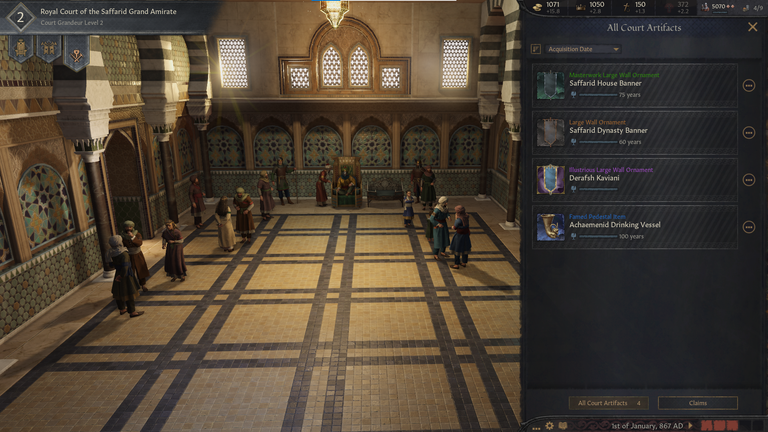
The Achaemenid Drinking Vessel, Oxus Bracelet, and Incense Burner Sculpture require the Legacy of Persia DLC. The Achaemenid Drinking Vessel and Oxus Bracelet are not unique. Other Drinking Vessels and Oxus Bracelets (of varying quality levels) can be found during random travel events in the Persia region. These Drinking Vessels are found as trinkets but can be converted into pedestal items. The Oxus Bracelets can have varying effects. Amir-e Amiran Nasr Ahmadzde of the Samanid Grand Amirate will always start with an Illustrious Oxus Bracelet, but the exact effects may vary from game to game. I have not found any additional Incense Burner Sculptures so it is unknown whether or not it is unique.
The various Pitaka books are also not unique. Additional copies can be found from Adventure Inspirations. So it is possible to have 2 different Vinaya Pitakas displayed in your royal court, giving you +2 max Sway schemes.
7. RANDOM RELIGIOUS ARTIFACTS
At the start of the game in 867, around 22 random religious artifacts seem to be randomly generated and distributed. The breakdown seems to be: 6 Christian, 6 Muslim, 4 Buddhist, 2 Hindu, 2 Asatru, 1 Slavic, and 1 Senegambian.
There do not seem to be randomly generated artifacts for Judaism, Jainism, Zoroastrianism, Finno-Ugric, or Tengri even though such religious artifacts exist in the game and the 867 start has a Jewish Emperor (Khazaria), a Jainist King (Rashtrakuta/Karnata), and 3 Tengri Kings (Kirghiz Khanate, Oghuz il, and Zhetysu).
And even though the 867 start has Kings/Emperors that are Khyarwe Bon (U), Manichean (Qocho), Soninke (Ghana), Taltosist (Mogyer Confederation), and Taoist (Guiyi), there doesn't seem to be any special artifacts for those religions right now.
A. 6 Random Christian Artifacts
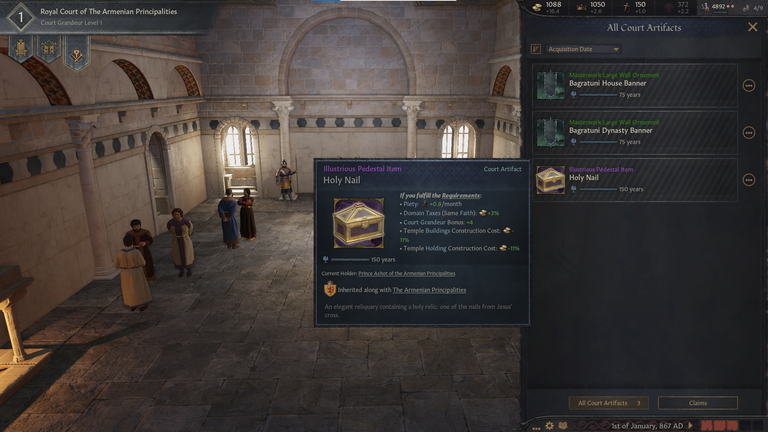
6 Christian artifacts are randomly generated and randomly distributed among the Christian rulers with a royal court (i.e. not to any Counts or Dukes and not to a theocracy). There seems to be a limit of one random Christian artifact per ruler, but it is possible for a ruler with a Fixed Historic Artifact (like Basileus Basileious, King Charles, or King Causantin) to also get a random religious artifact.
In the 867 start there are 13 non-Theocratic Christian rulers with a royal court who are eligible to receive such a random Christian Artifact: the Byzantine Empire, the Armenian Principalities, and the Kingdoms of Abyssinia, Alba, Asturias, Brittany, Bulgaria, East Francia, Great Moravia, Italy, Lotharingia, Navarra, and West Francia. As a result, there is a 6/13 chance that any of these rulers will start with one.
In Version 1.11 Peacock, most of the 6 random Christian artifacts tend to be Illustrious (though I've also seen cases where 5 are Illustrious and 1 is Common). Back during Version 1.6 Castle, the distribution tended to be 3 Illustrious + 3 Masterwork or 4 Illustrious + 2 Masterwork (and one time I did see 5 Illustrious + 1 Masterwork).
There can only be one Crown of Thorns, Girdle of Mary, Loincloth of Jesus, Sandals of Jesus, Spear of Destiny, and Veil of Veronica but there can be multiple Arms of St. George, Skulls of St. John the Evangelist, Fragments of the True Cross, Holy Nails, and Holy Thorns.
B. 6 Random Muslim Artifacts
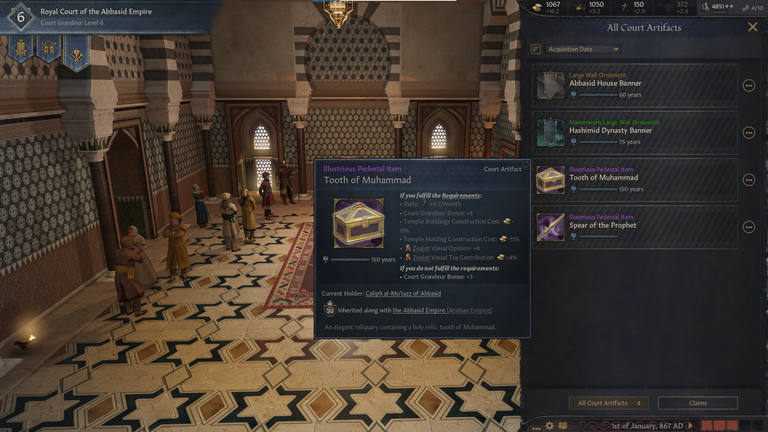
6 Muslim artifacts are randomly generated and randomly distributed among the Muslim rulers with a royal court (i.e. not to any Counts or Dukes). There seems to be a limit of one random Muslim artifact per ruler, but it is possible for a ruler with a Fixed Historic Artifact (like Caliph al-Mu'tazz, Amir-e Amiran Ya'qub Laythzade, Amir-e Amiran Nasr Ahmadzde, or Amir-e Amiran Muhammad Tahirzde) to also get a random religious artifact.
In the 867 start there are 9 Muslim rulers with a royal court who are eligible to receive such a random Muslim Artifact: the Arabian Empire, and the Kingdom/Sultanates of Aghlabid (Africa), al-Andalus, Habbari (Singh), Idrisid (Maghreb), Saffarid (Makran), Samanid (Transoxiana), Tahirid (Khorasan), and Tulunid (Egypt). As a result, there is a 6/9 chance that any of these rulers will start with one.
In Version 1.11 Peacock, most of the 6 random Muslim artifacts tend to be Illustrious. Back during Version 1.6 Castle, the distribution tended to be 3 Illustrious + 3 Masterwork or 4 Illustrious + 2 Masterwork.
There can only be one Cloak of Muhammad, Hand of Yahya, Holy Banner of Muhammad, Keys to the Kaaba, and Seal of Muhammad but there can be multiple Swords of Muhammad, Hairs of Muhammad, and Teeth of Muhammad.
C. 4 Random Buddhist Artifacts
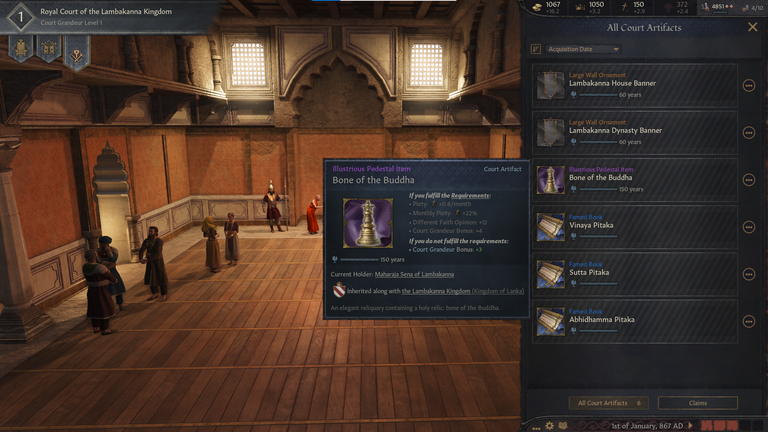
In the 867 start there are 4 Buddhist rulers with a royal court so each of them starts with a random Buddhist artifact. These four are the kingdoms of Guge, Lambakanna (Lanka), Pala (Bengal), and Vijaya (Khotan). The name and the abilities of the artifacts are randomly generated at game start and not fixed.
In Version 1.11 Peacock, these 4 random Buddhist artifacts tend to be Illustrious. Back during Version 1.6 Castle, the Buddhist artifacts were occasionally Illustrious but often were Masterwork or Common (one time the game started with 0 Illustrious + 4 Masterwork).
There can only be one Alms-bowl of the Buddha, Robes of the Buddha, and Tongue of Kumarajiva but there can be multiple Bones of the Buddha, Branches of the Bo Tree, Hairs of the Buddha, Sariras, and Teeth of the Buddha.
D. 2 Random Hindu Artifacts
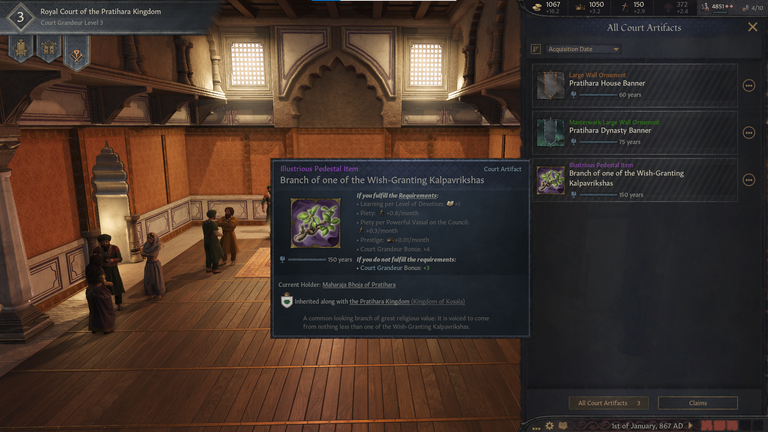
Exactly 2 Illustrious Branch of one of the Wish-Granting Kalpavrikshas are randomly generated and randomly distributed among Hindu rulers with a royal court (i.e. not to any Counts or Dukes). There seems to be a limit of one random Hindu artifact per ruler.
In the 867 start there are 3 Hindu rulers with a royal court: Mlechchha (Kamarupa), Pratihara (Kosala), and Utpala (Kashmir), so two of them will start with a Hindu artifact and one of them will not.
E. 2 Random Asatru Artifacts
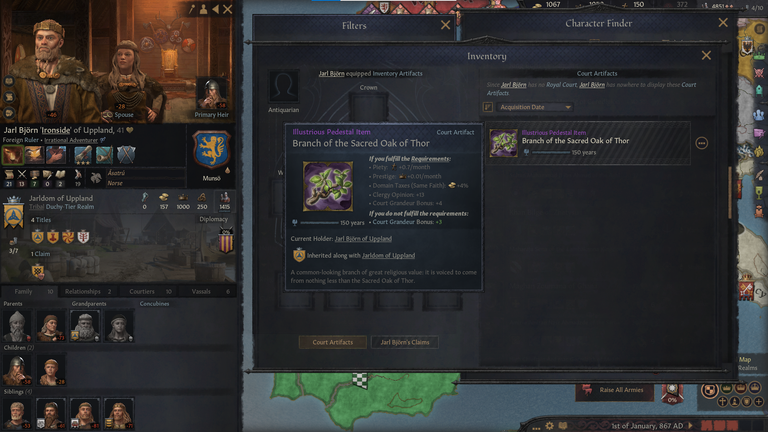
Exactly 2 Illustrious artifacts are randomly generated and randomly distributed among Asatru rulers or mercenary leaders, regardless of whether or not they have a royal court (since neither 867 or 1066 have any Asatru Kings or Emperors). There seems to be a limit of one random Asatru artifact per ruler.
In the 867 start, there are 10 dukes, 5 mercenary bands, and 36 counts who are eligible candidates. As a result, there is only a 2/51 chance that any given Asatru ruler starts with one.
The 2 artifacts can be either Branch of the Sacred Oak of Thor or Branch of the Sacred Tree at the Temple of Uppland. It is possible that one of each is generated or it is possible that both artifacts are the same name/type.
Unlike the Christian, Muslim, Buddhist, and Hindu religious artifacts which can only be given to a ruler with a royal court, the Asatru, Slavic, and Senegambian religious artifacts can be given to a ruler without a royal court since there are no starting characters who are King or Emperor level. It is also possible for an Asatru, Slavic, or Senegambian mercenary leader to start with a religious artifact.
F. 1 Random Slavic Artifact
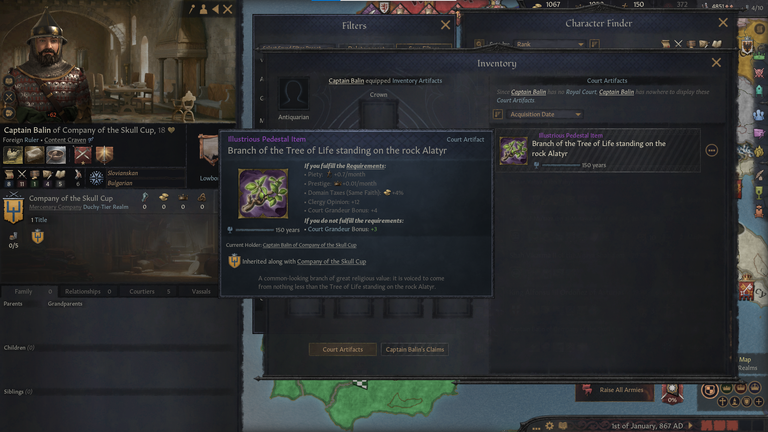
Exactly one Illustrious Branch of the Tree of Life standing on the rock Alatyr is randomly generated and randomly given to a Slavic ruler or mercenary leader, regardless of whether or not they have a royal court (since neither 867 or 1066 have any Slavic Kings or Emperors).
In the 867 start, there are 10 dukes, 16 mercenary bands, and 46 counts who are eligible candidates. As a result there is only a 1/72 chance that any given Slavic ruler starts with the Illustrious Branch.
G. 1 Random Senegambian Artifact
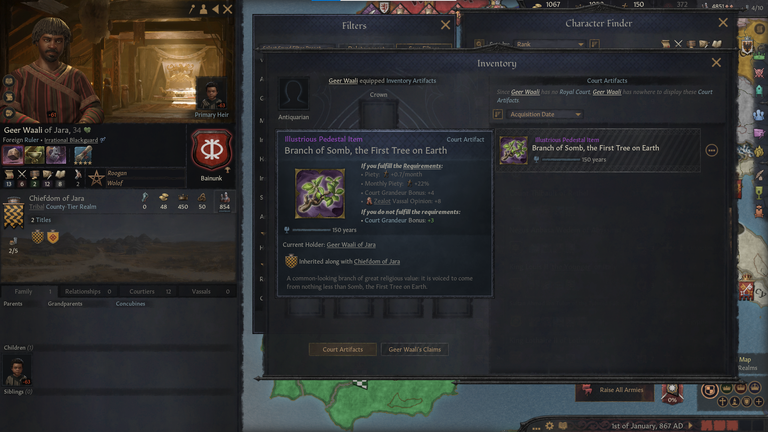
Exactly one Illustrious Branch of Somb, the First Tree on Earth is randomly generated and randomly given to a Senegambian ruler or mercenary leader, regardless of whether or not they have a royal court (since neither 867 or 1066 have any Senegambian Kings or Emperors).
In the 867 start, there are 1 duke, 6 mercenary bands, and 12 counts who are eligible candidates. As a result there is only a 1/19 chance that any given Senegambian ruler starts with the Illustrious Branch.
8. RANDOM NON-UNIQUE ARTIFACTS
A. 5 Visigothic Votive Crowns
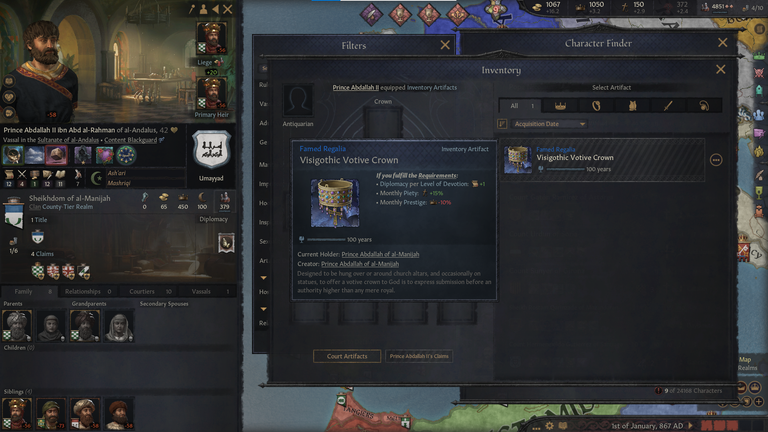
If you have the Fate of Iberia DLC, then 5 random Christian or Muslim rulers in Iberia (of Count rank or higher) will start with a Famed quality Visigothic Votive Crown (which is regalia and not a crown, despite its name). These all have identical stats and are only usable by Christians (even though some Muslims may start with one). Since this is an inventory item, it is possible for rulers without a royal court to start with one. There does seem to be a limit of one starting Visigothic Votive Crown per ruler.
B. 6 Excaliburs
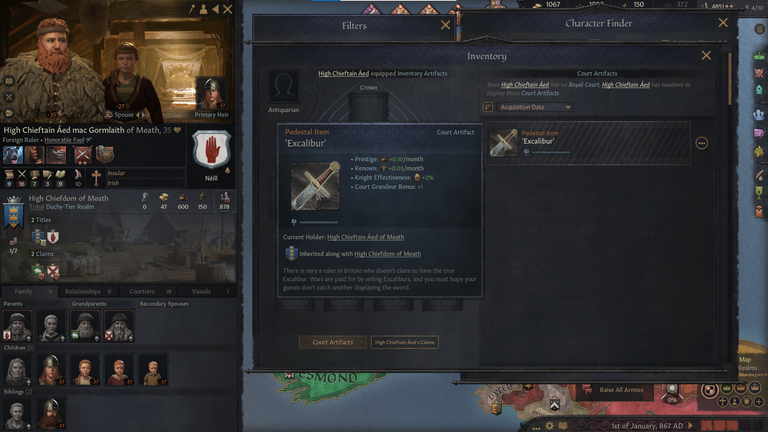
The game also seems to randomly generate 6 Common Excaliburs (all with identical stats). Even though this is a royal court (pedestal) artifact, these seem to be randomly distributed among 6 different rulers WITHOUT a royal court (i.e. Counts or Dukes) in Britannia or Francia. There does seem to be a limit of one starting Excalibur per ruler.
9. ANALYSIS
If you enjoy artifact hunting and want a good start then the Byzantine Empire or the Kingdom of Lanka each start with 3 fixed royal court artifacts. The Arabian Empire starts with 1 inventory artifact and 1 royal court artifact. The Kingdom of Makran starts with 2 royal court artifacts. The kingdoms of West Francia, Alba, Transoxiana, and Korasan each start with 1 royal court artifact. And the Counts of Santiago and Mazandaran each start with 1 inventory artifact. The Papacy is not playable because it is a theocracy.
Furthermore, if you really want to optimize things you can keep restarting the game until your chosen ruler starts with a random religious artifact (preferably an Illustrious one). The 4 Buddhist Kings are guaranteed to get a random religious artifact, the 3 Hindu Kings and the 9 Muslim Kings/Emperors have a 2/3 chance of getting one, and the 13 Christian Kings/Emperors have a 6/13 chance of starting with one.
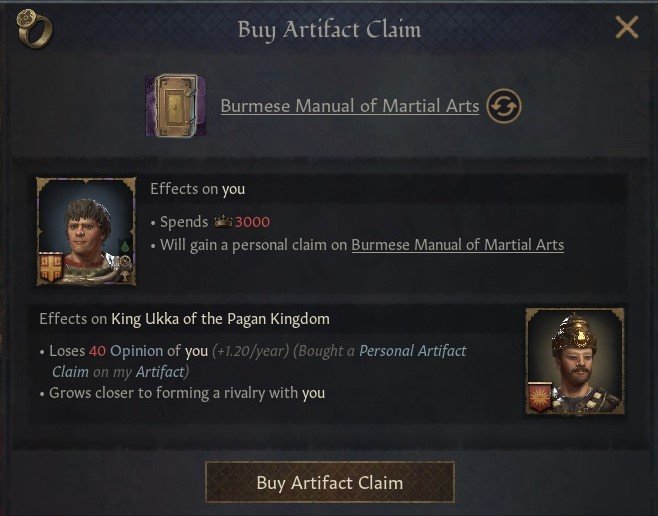
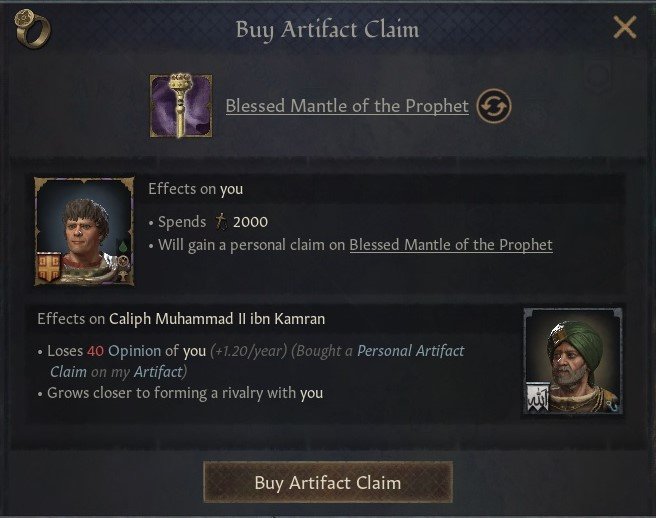
If you want to collect artifacts in your game, then the most reliable method is to pursue the Diplomat perk tree for the Accomplished Forger perk. Once you have that perk, you can spend prestige or faith to get a claim on an artifact and once you have a claim, you can demand it, declare a war for it, duel for it, or steal it with a hostile scheme. Demanding or dueling for an artifact has a multi-year cooldown. Stealing an artifact has a cooldown against that same target but no cooldown against different rulers. It is possible to loot artifacts by sieging a character's capital holding but you have an extremely low chance of looting an Illustrious artifact. One other option is if you usurp a kingdom/empire title so that the artifact holder no longer has a royal court, then you will immediately "inherit" their royal court artifacts.
Also, if you want to appropriate these artifacts, your realm will need sufficient diplomatic range. The Byzantine Empire, Arabian Empire, and West Francia are fairly central from the Mediterranean. Santiago is very far west though and to get diplomatic contact with Alba will require some effort. Similarly, Makran is fairly eastward while Lanka is all the way at the eastern edge of the map. Controlling the Rock of Gibraltar can help expand your diplomatic range and you may want to leapfrog across sea zones.
However, you can skip artifacts that you don't meet the requirements for. You can always skip the Papal Tiara unless you want the bragging rights. Non-Muslims can ignore the artifacts held by the Arabian Empire. There is no need to acquire Makran's Derafsh Kaviani if you aren't Iranian culture. And if you don't plan to be involved in the Iberian Struggle or you are not Christian or Muslim, you can bypass the Bells of Santiago.
It can be hard to get a good throne since you can't specifically commission one, which makes the Stone of Scone tempting. The Skull Cap of Charlemagne makes your knights more effective and decreases the maintenance for your men-at-arms. The Crown of Justinian increases your domain and vassal limits. And the Pitaka books provide lots of renown and piety, as well as other benefits. Thus, Alba, West Francia, the Byzantine Empire, and Lanka are the juiciest targets for powerful artifacts that can be used by any character.
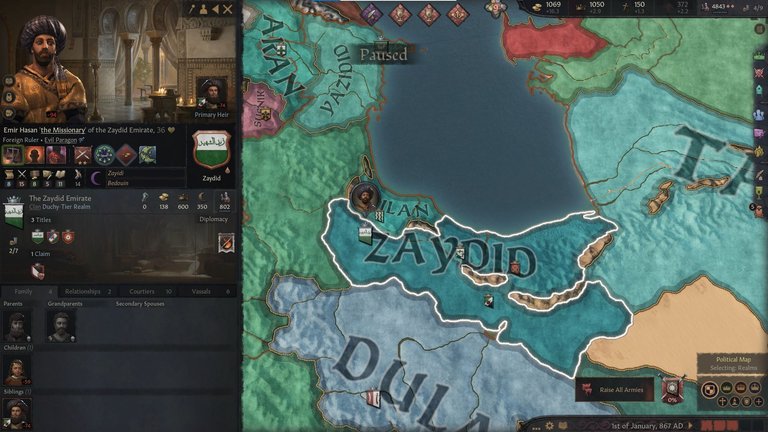
Also, if you are outside the Persian region but want to get involved in the Iranian Intermezzo, then Mazandaran, other parts of Tabaristan, or Gilan can be a good entry point since the rulers are Zayidi and not Ash'ari. That means you can Holy War them without worrying about all their neighbors joining in to defend them.
Updated April 6th, 2024:
Added links to the 1066 article and the 867 vs 1066 comparison article
Added screenshots of two of the random events in the Persia region that can give you random artifacts
Confirmed that Achaemenid Drinking Vessels come in all 4 quality levels
Made a slight wording correction since I discovered Tengri artifacts do in fact exist in the game (though there are none in the 867 start)
Added screenshots of using Accomplished Forger to buy artifact claims
Added a screenshot of where you can conveniently enter Persia to get involved in the Iranian Intermezzo